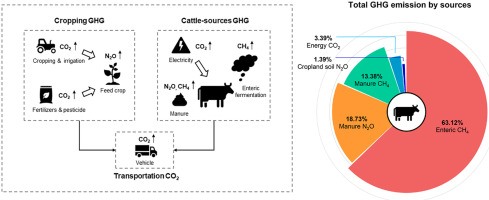当前位置:
X-MOL 学术
›
J. Environ. Manag.
›
论文详情
Our official English website, www.x-mol.net, welcomes your feedback! (Note: you will need to create a separate account there.)
Assessment of regional greenhouse gas emission from beef cattle production: A case study of Saskatchewan in Canada.
Journal of Environmental Management ( IF 8.7 ) Pub Date : 2020-03-25 , DOI: 10.1016/j.jenvman.2020.110443 Zhikun Chen 1 , Chunjiang An 1 , Hanxiao Fang 2 , Yunlu Zhang 2 , Zhigang Zhou 2 , Yang Zhou 3 , Shan Zhao 4
Journal of Environmental Management ( IF 8.7 ) Pub Date : 2020-03-25 , DOI: 10.1016/j.jenvman.2020.110443 Zhikun Chen 1 , Chunjiang An 1 , Hanxiao Fang 2 , Yunlu Zhang 2 , Zhigang Zhou 2 , Yang Zhou 3 , Shan Zhao 4
Affiliation

|
The beef cattle production has been considered as one of the largest sources of greenhouse gases (GHGs) emission. A large amount of GHGs including N2O and CH4 from enteric fermentation and manure are discharged to atmosphere during beef-production process. In addition, a substantial amount of GHGs is also emitted from many other related processes such as feed production, transportation, and energy consumption. In this study, an emission assessment model was developed to quantify the amount of regional GHGs produced from the beef cattle production process. A case study was conducted based on the beef production in Saskatchewan, Canada. The results demonstrated that the GHG emissions from the annual marketed beef cattle in Saskatchewan in 2014 were 8.52 × 109 kg CO2-eq in total and the cattle-source GHGs (enteric CH4, manure CH4, and manure N2O emission) accounted for more than 90% of the total emission. Sensitivity analysis showed that the most critical factors influencing the GHG emission included feedlot manure handling system, cattle diet, feed additives, maximum methane producing capacity (Bo), and climate (temperature, precipitation, and potential evapotranspiration). The potential impacts of climate change on GHG emission from beef cattle production in Saskatchewan were also investigated. An overall decrease in the GHG emission can be observed due to the climate change, which are 3.67%, 4.96%, and 6.63% for 2020-2039, 2040-2059, and 2060-2099, respectively.
中文翻译:

肉牛生产引起的区域温室气体排放评估:以加拿大萨斯喀彻温省为例。
肉牛生产被认为是最大的温室气体排放源之一。在牛肉生产过程中,肠内发酵和粪便产生的大量NHG和CH4排放到大气中。此外,许多其他相关过程(如饲料生产,运输和能源消耗)还会排放大量的温室气体。在这项研究中,建立了排放评估模型以量化肉牛生产过程中产生的区域性温室气体的数量。基于加拿大萨斯喀彻温省的牛肉生产进行了案例研究。结果表明,2014年萨斯喀彻温省每年销售的肉牛的温室气体排放总量为8.52×109千克二氧化碳当量,以及牛源温室气体(肠溶CH4,粪便CH4,粪便中的N2O排放量占总排放量的90%以上。敏感性分析表明,影响温室气体排放的最关键因素包括肥育场粪便处理系统,牛饲料,饲料添加剂,最大甲烷生产能力(Bo)和气候(温度,降水和潜在蒸散量)。还研究了气候变化对萨斯喀彻温省肉牛生产中温室气体排放的潜在影响。由于气候变化,可以观察到温室气体排放量的总体下降,2020-2039年,2040-2059年和2060-2099年分别为3.67%,4.96%和6.63%。最大甲烷生产能力(Bo)和气候(温度,降水和潜在蒸散量)。还研究了气候变化对萨斯喀彻温省肉牛生产中温室气体排放的潜在影响。由于气候变化,可以观察到温室气体排放量的总体下降,2020-2039年,2040-2059年和2060-2099年分别为3.67%,4.96%和6.63%。最大甲烷生产能力(Bo)和气候(温度,降水和潜在蒸散量)。还研究了气候变化对萨斯喀彻温省肉牛生产中温室气体排放的潜在影响。由于气候变化,可以观察到温室气体排放量的总体下降,2020-2039年,2040-2059年和2060-2099年分别为3.67%,4.96%和6.63%。
更新日期:2020-03-26
中文翻译:

肉牛生产引起的区域温室气体排放评估:以加拿大萨斯喀彻温省为例。
肉牛生产被认为是最大的温室气体排放源之一。在牛肉生产过程中,肠内发酵和粪便产生的大量NHG和CH4排放到大气中。此外,许多其他相关过程(如饲料生产,运输和能源消耗)还会排放大量的温室气体。在这项研究中,建立了排放评估模型以量化肉牛生产过程中产生的区域性温室气体的数量。基于加拿大萨斯喀彻温省的牛肉生产进行了案例研究。结果表明,2014年萨斯喀彻温省每年销售的肉牛的温室气体排放总量为8.52×109千克二氧化碳当量,以及牛源温室气体(肠溶CH4,粪便CH4,粪便中的N2O排放量占总排放量的90%以上。敏感性分析表明,影响温室气体排放的最关键因素包括肥育场粪便处理系统,牛饲料,饲料添加剂,最大甲烷生产能力(Bo)和气候(温度,降水和潜在蒸散量)。还研究了气候变化对萨斯喀彻温省肉牛生产中温室气体排放的潜在影响。由于气候变化,可以观察到温室气体排放量的总体下降,2020-2039年,2040-2059年和2060-2099年分别为3.67%,4.96%和6.63%。最大甲烷生产能力(Bo)和气候(温度,降水和潜在蒸散量)。还研究了气候变化对萨斯喀彻温省肉牛生产中温室气体排放的潜在影响。由于气候变化,可以观察到温室气体排放量的总体下降,2020-2039年,2040-2059年和2060-2099年分别为3.67%,4.96%和6.63%。最大甲烷生产能力(Bo)和气候(温度,降水和潜在蒸散量)。还研究了气候变化对萨斯喀彻温省肉牛生产中温室气体排放的潜在影响。由于气候变化,可以观察到温室气体排放量的总体下降,2020-2039年,2040-2059年和2060-2099年分别为3.67%,4.96%和6.63%。



























 京公网安备 11010802027423号
京公网安备 11010802027423号